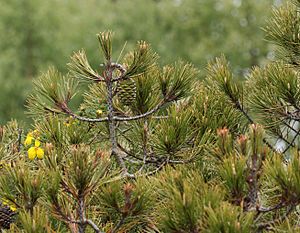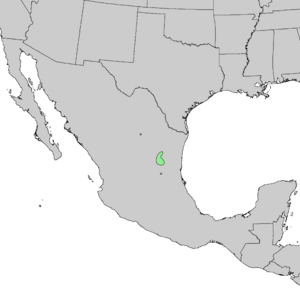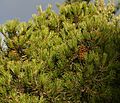Pinus nelsonii facts for kids
Quick facts for kids Pinus nelsonii |
|
|---|---|
 |
|
| Conservation status | |
| Scientific classification | |
 |
|
| Natural range of Pinus nelsonii |
Pinus nelsonii, also called Nelson's Pinyon, is a special type of pine tree. It grows in the mountains of northeastern Mexico, in states like Nuevo León, San Luis Potosí, and Tamaulipas. You can find it high up, between 1,800 and 3,200 meters (about 5,900 to 10,500 feet) above sea level. This tree is known for its tasty seeds, which people in Mexico love to eat!
Contents
Nelson's Pinyon Tree
Nelson's Pinyon is a small tree. It usually grows up to 10 meters (about 33 feet) tall. Its trunk can be about 20 to 30 centimeters (8 to 12 inches) wide. The top part of the tree, called the crown, is round and thick. It looks a bit like the Stone pine from the Mediterranean region.
Unique Needles and Cones
The needles of this pine tree are quite interesting. They usually grow in groups of three. Sometimes, there are four needles together. They are "zipped" up by their edges, so they look like one single needle. You have to pull them apart to see they are separate!
These needles are about 4 to 8 centimeters (1.5 to 3 inches) long. They are dark green and a bit shiny. They also have a gray base that stays on the tree.
The cones are shaped like cylinders. They are about 6 to 12 centimeters (2.5 to 5 inches) long. They are orange-brown or red-brown in color. Each cone has many scales, usually 60 to 100. Unlike other pines, these cones keep growing through their first winter.
Seeds and Habitat
The seeds of Nelson's Pinyon are quite large, about 12 to 15 millimeters (half an inch). They are red-brown. The cones are ready in November, after the rainy season.
This tree grows in a warm, dry climate. It gets rain in the summer. It is very good at handling dry conditions. This means it can survive even when there isn't much water.
Why Nelson's Pinyon is Special
The seeds of Nelson's Pinyon are edible and very delicious. People in the region really enjoy them. They are so valuable that they are even sent to markets in Mexico City.
Because its seeds are so popular, many of these trees have been cut down. This has made them less common. Recently, people have started growing this tree outside its natural home. They grow it more for its unique features than for its beauty.
Sometimes, you might see the scientific name written as Pinus nelsoni. But the correct way to write it is Pinus nelsonii.
Images for kids
See also
 In Spanish: Piñón prieto para niños
In Spanish: Piñón prieto para niños





